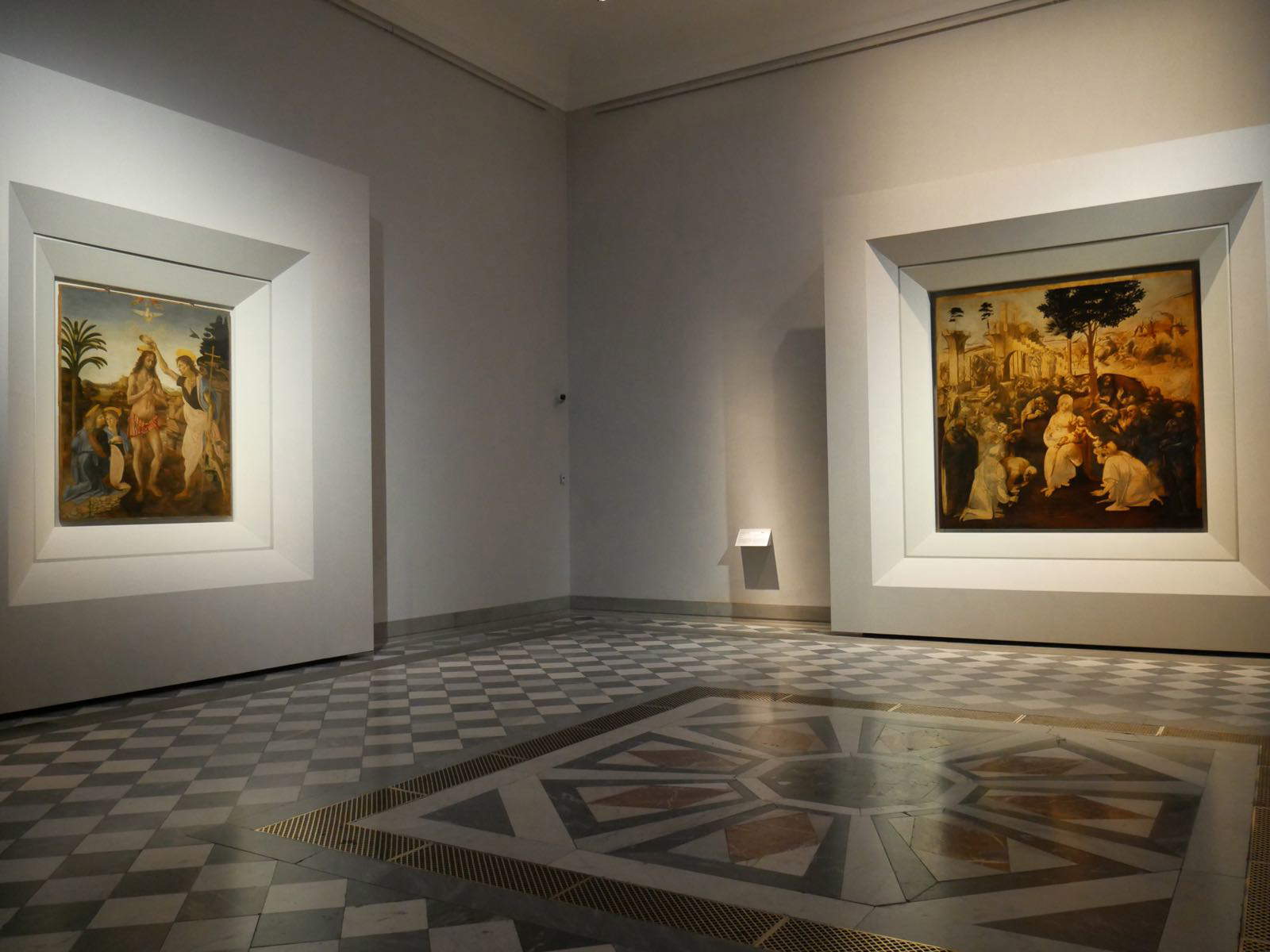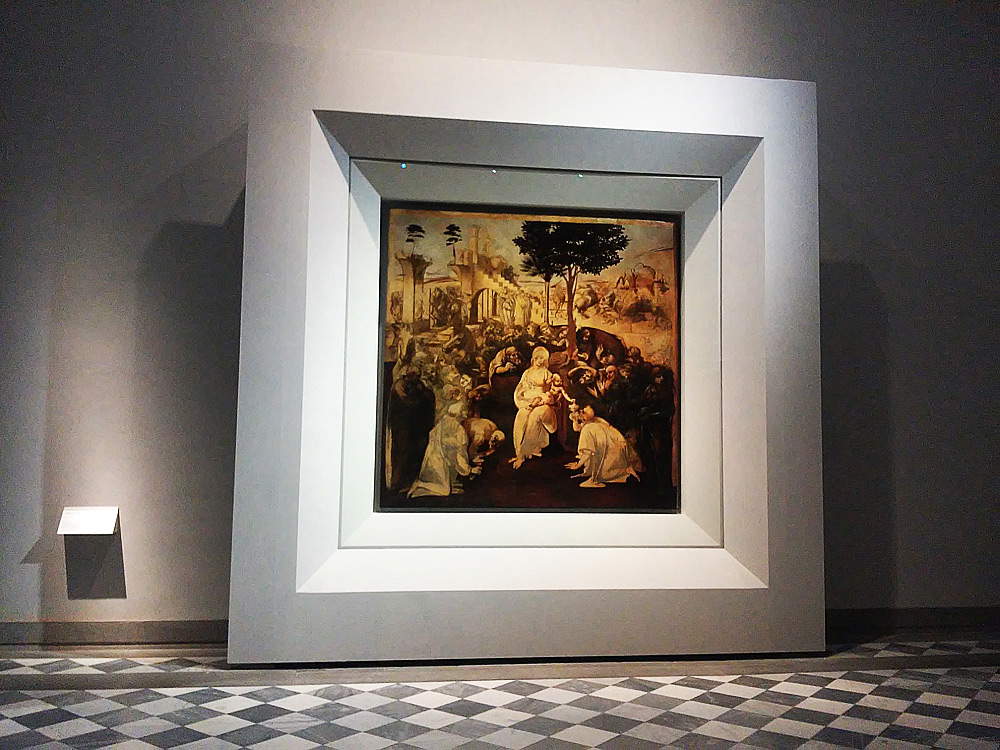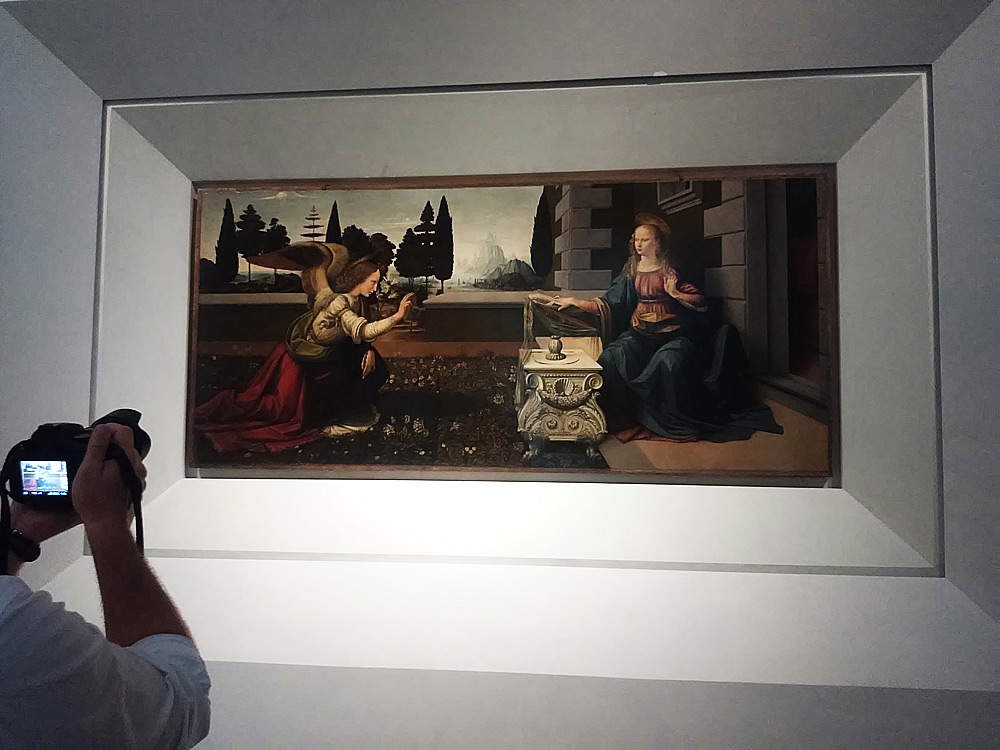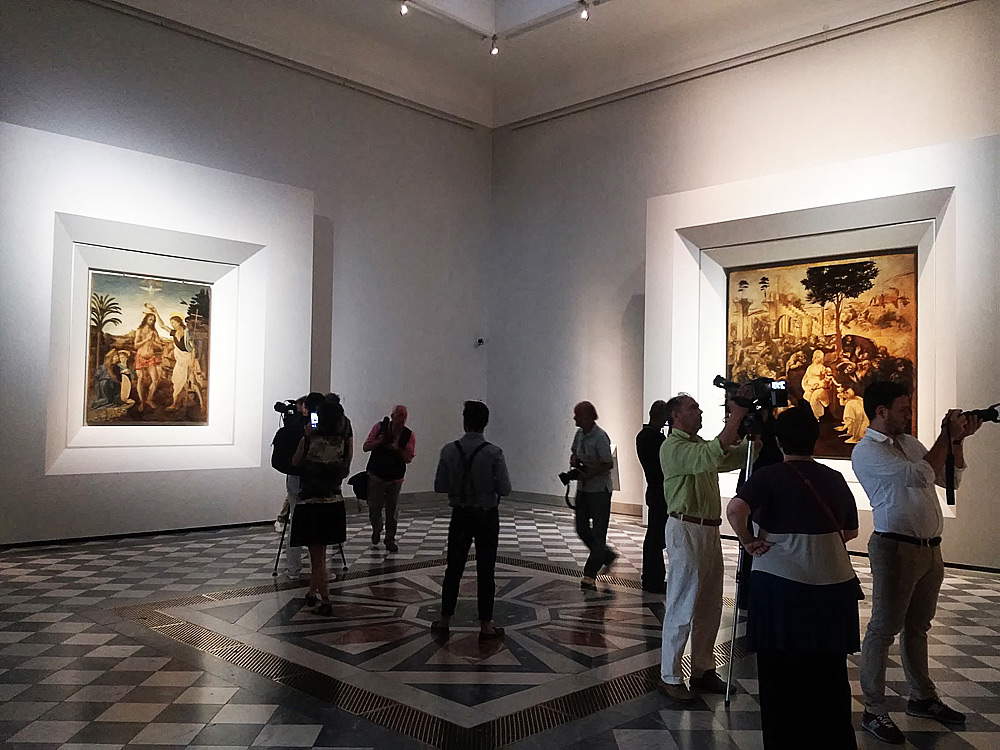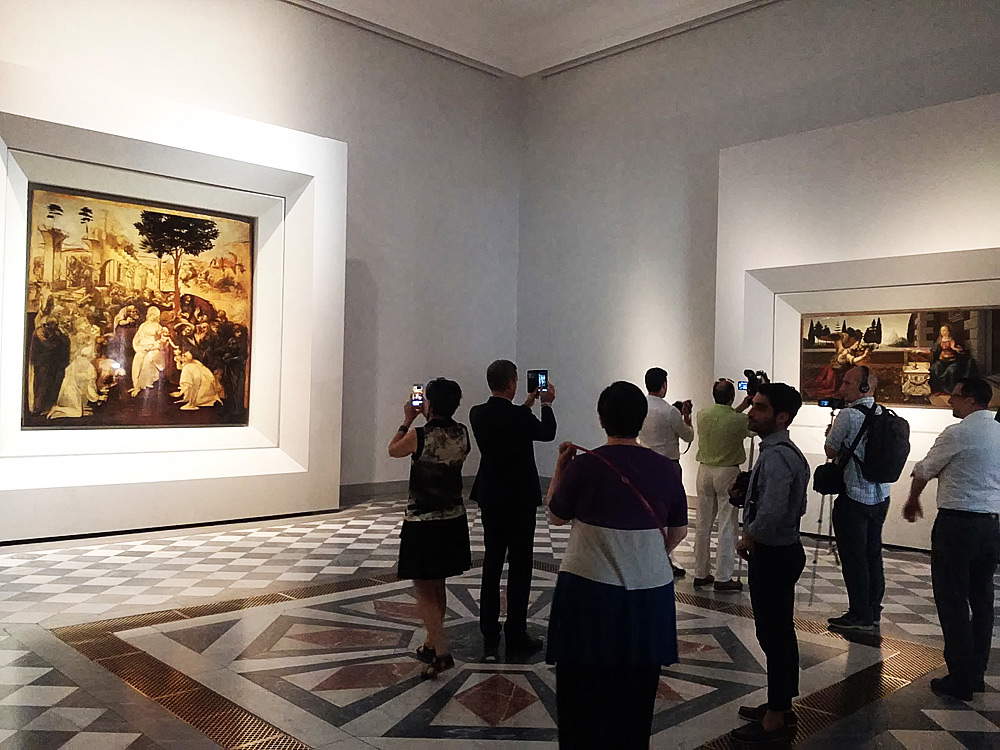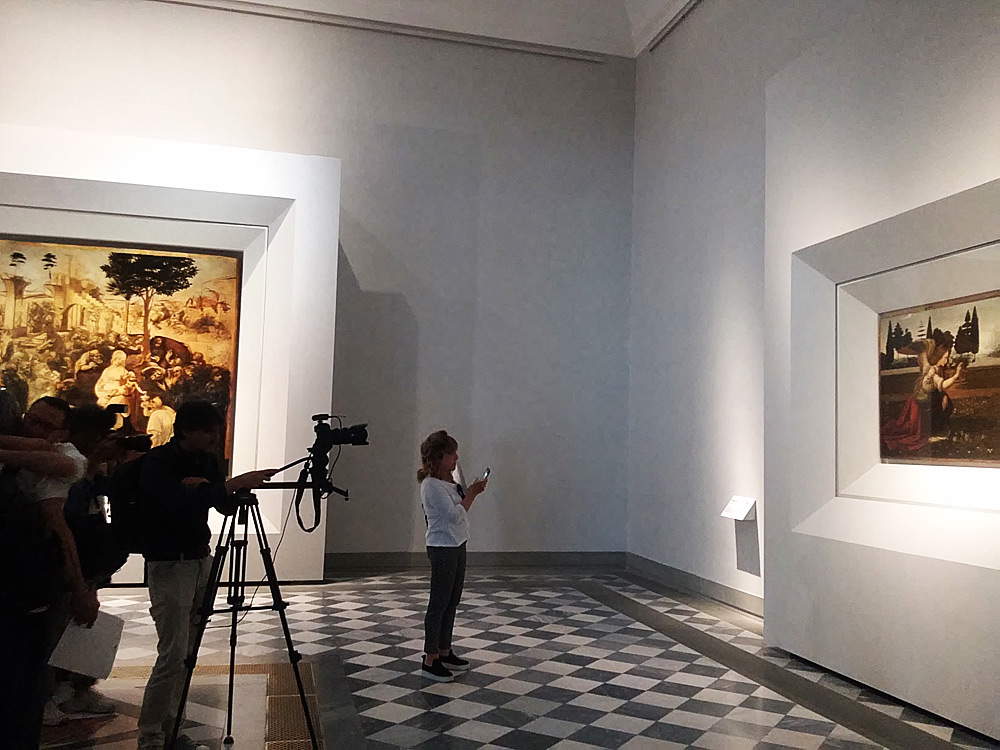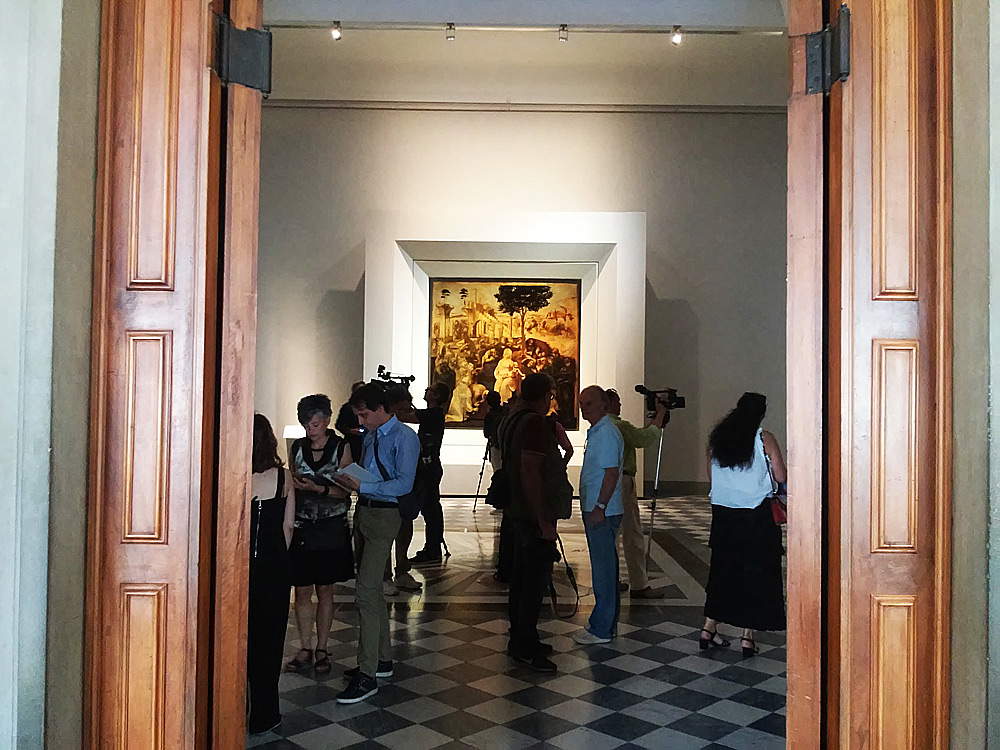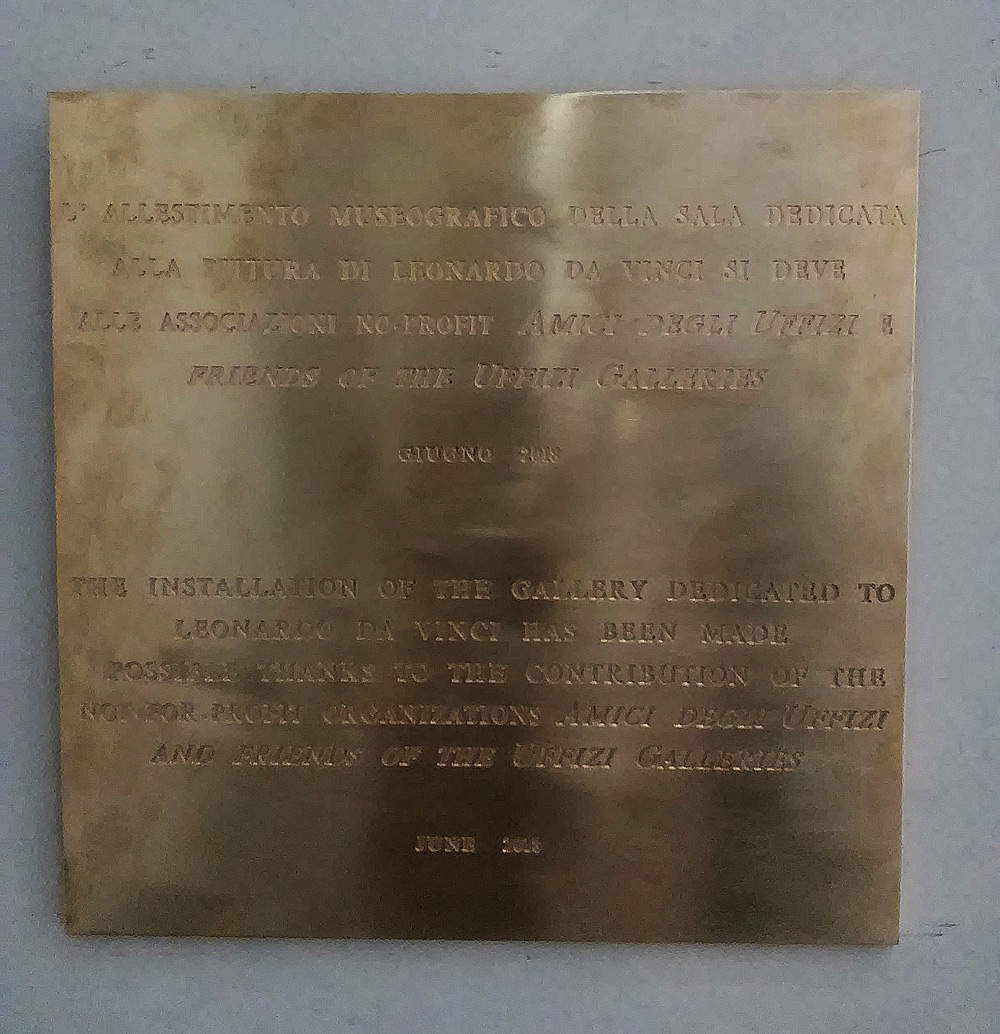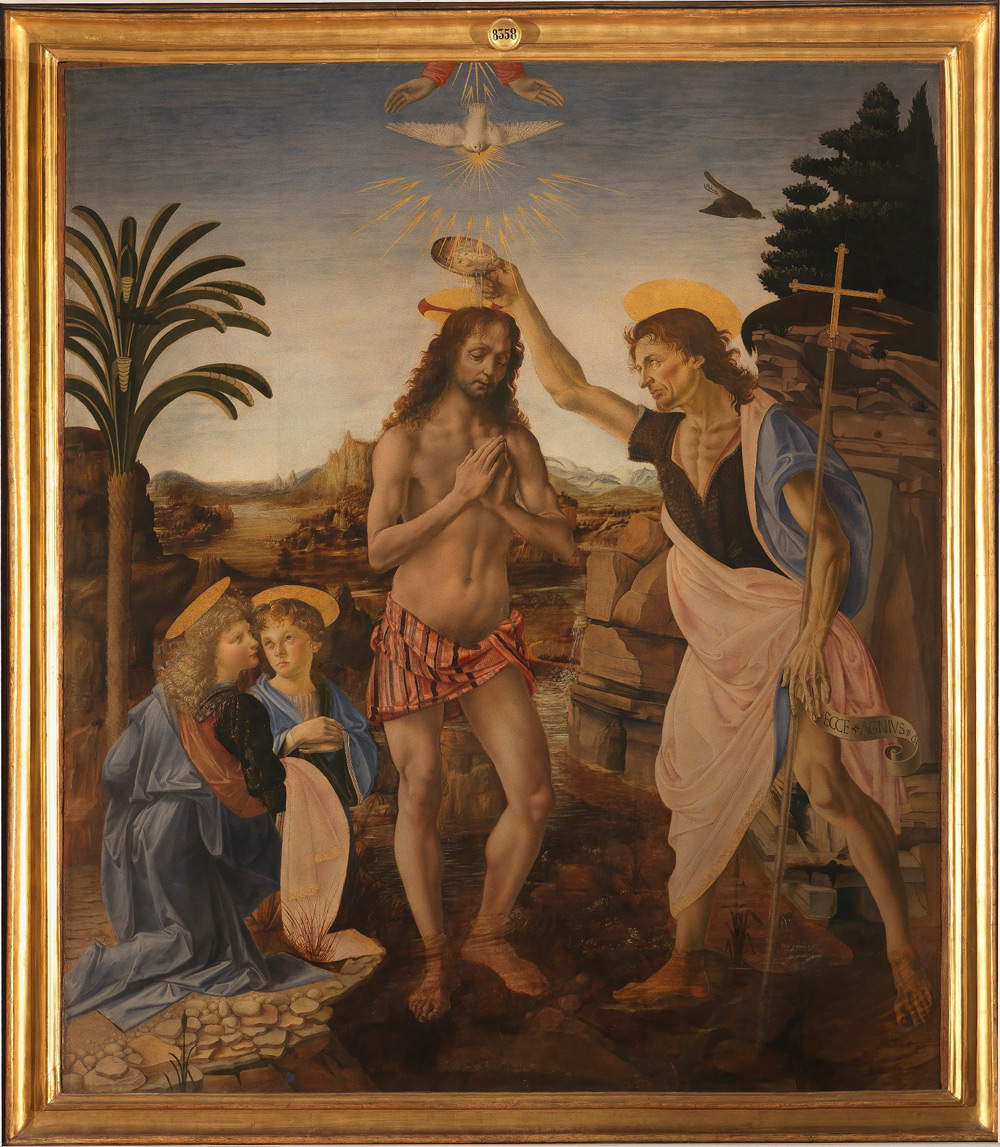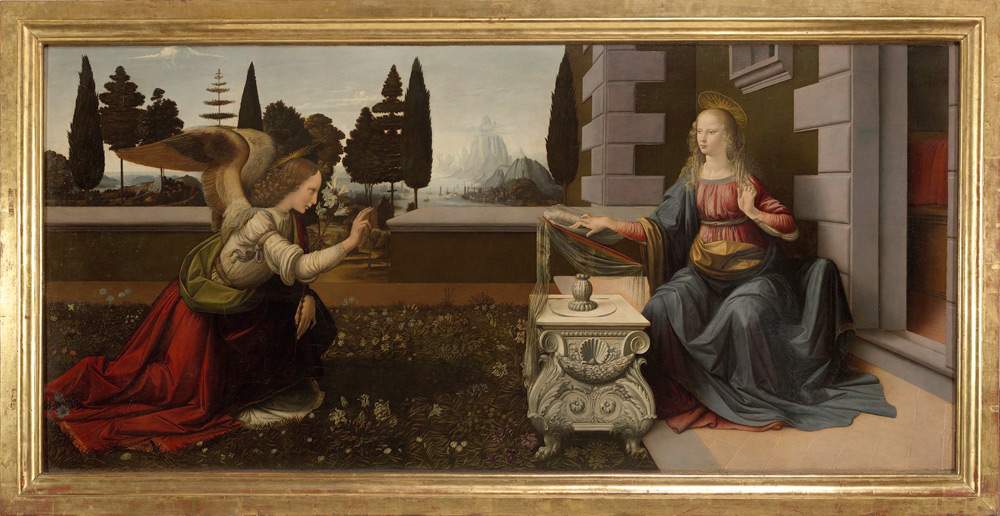by Redazione , published on 09/07/2018
Categories: News Focus
/ Disclaimer
New room dedicated to Leonardo da Vinci opens at the Uffizi. Exclusive preview photos and statements from all involved in the operation.
At the Uffizi in Florence opens to the public from tomorrow, Tuesday, July 10, 2018, the new room dedicated to the masterpieces of Leonardo da Vinci (Vinci, 1452 - Amboise, 1519): the Baptism of Christ, executed together with Verrocchio, theAnnunciation and theAdoration of the Magi, reunited in a single room with new fittings designed by architect Antonio Godoli. All made possible thanks to the support of the Amici degli Uffizi and Friends of the Uffizi Galleries associations. The room is intended to recreate the atmosphere in Florence in 1504, when Raphael Sanzio, just 21 years old, arrived in the city: according to Giorgio Vasari’s account, the Urbino came to the city attracted by the fame of Leonardo da Vinci and Michelangelo’s cartoons, made in preparation for the decoration of the Sala Grande in Palazzo Vecchio (Leonardo is said to have painted the Battle of Anghiari, Michelangelo the Battle of Cascina). Leonardo, in particular, had returned to Florence in 1503, after spending two decades in Milan at the court of Ludovico il Moro.
He was, in essence, back where he had started: in Florence he had in fact begun studying at Verrocchio’s workshop, and in the Tuscan capital he had created his first works. Three of his earliest masterpieces can therefore be admired in Room 35 of the Uffizi’s west wing, immediately before the room, inaugurated last month, dedicated to Michelangelo and Raphael: these are three works made for houses of worship, and for this reason the new layout wanted to place them in three large display cases whose pale gray recalls that of the walls of the churches of the time. The vitrines ensure an optimal microclimatic situation that minimizes the impact of the heat and humidity that are produced by the many visitors, and the special glass placed to protect the works cancel out light reflections, allowing full and complete enjoyment of the paintings.
Entering the room, one will find on the left the Baptism of Christ, which, as mentioned, Leonardo created in collaboration with Verrocchio between 1475 and 1478: the work testifies both to the divisions of tasks within the workshops and to the stylistic and technical leap between master and pupil. Leonardo, in fact, used oil painting for the parts he executed, which was much better suited to achieving the shaded effects for which he would later become famous. To Leonardo alone is attributed the Angel inProfile holding the robe of Christ, so sublime that it gave rise to the legend (reported by Vasari) that Verrocchio, overwhelmed by Leonardo’s superiority, would from then on abandon painting forever. On the right wall is theAnnunciazione, from the church of Monteoliveto, with the famous angel who is so real and material that he casts his shadow on the flowery meadow as he lands, closing the wings that Leonardo studied from life by observing those of birds. In the background we find a landscape of sea and mountains in which Marian symbolism is translated into one of the artist’s highest tests of the atmospheric rendering of the distant. Finally, in the center of the room, visitors will admire theAdorationof the Magi, commissioned by the Augustinian regular canons for the church of San Donato a Scopeto, near Florence, and left unfinished at the time Leonardo left for Milan in 1482. Recently restored by the Opificiodelle Pietre Dure thanks to funding from the Amici degli Uffizi, with a work of more than five years, also important for the methodological innovations adopted and for the extraordinary results obtained, the altarpiece is like a huge page of notes, with some passages more advanced, others barely hinted at, so much so that looking at it almost seems to participate in Leonardo’s own creative process.
What we are presenting today, said the director of the Uffizi, Eike D. Schmidt, is a milestone in the reorganization of the Uffizi rooms: in fact, here we reunite, for the first time in a long time, theAnnunciation, theAdoration of the Magi and the Baptism of Christ. Moreover, theAdoration of the Magi returns for the first time reunited with the other two works after the fundamental restoration that kept it away for so long. And again, with this display Leonardo returns to his chronological place, between the late fifteenth century represented by the rooms devoted to Florentine and Central Italian painting of the second half of the fifteenth century, and the room devoted to Raphael and Michelangelo inaugurated exactly a month ago. So although the works we see in this room are all from Leonardo’s early period, from the period before he left for Milan, these inventions were also fundamental for the other geniuses of Florence in the first decade of the 16th century, who reacted with their works to Leonardo’s innovations. And then there are details in theAdoration that anticipate compositions of later years: I am thinking of the Battle of Anghiari, painted here in Florence in competition with Michelangelo for the Palazzo Vecchio. And, by the way, it is no coincidence that on Saturday evening we opened another exhibition, linked to the territory, the one dedicated to the Doria table that has returned from Japan and that depicts one of the oldest testimonies of the Battle of Anghiari (and therefore has great historical value). We are therefore starting the celebrations of Leonardo’s 500th anniversary earlier than the rest of the world, which from January 1 will also start abroad. In addition, from October 29 we will also have the exhibition of the Leicester Codex, which returns to Florence for the first time after 1984 and is interpreted thanks to other very rare loans of works by Leonardo da Vinci. As for the layout, we have based our choices on the maximum protection we can provide for these works: this was the fundamental criterion that guided the installation of the three vitrines, which we, as insiders, now call ’Godolian vitrines,’ because it is our architect Antonio Godoli who developed this technology and also this aesthetic of the vitrine that is based on the prism. And this is also important for the enhancement and the perception of these maximum masterpieces, because this way, and only this way, you can avoid the aquarium effect that otherwise there is necessarily when you make a case with glass in front. Here, visitors enter and immediately find the artworks, and not what is around them, the center of attention. We were inspired by Filippo Brunelleschi and Giorgio Vasari for the minimalism of the installation: we believe that the spirit behind the installation is entirely Florentine and Tuscan, and we are very proud of that. So much so that even the choice and application of colors were conducted according to Tuscan traditions of the sixteenth century, with hand-applied layering: we no longer use industrial acrylic colors as we did before, but these are natural Tuscan pigments, applied according to ancient techniques passed down from generation to generation. All this would not have been possible without the generosity of the Friends of the Uffizi and the Friends of the Uffizi.
Maria Vittoria Rimbotti Colonna, president of the Friends of the Uffizi and Friends of the Uffizi Galleries associations, emphasized that the moment is very exciting for our associations: today’s is a day we have been waiting for a long time and is along a path that began twenty-five years ago, when following the 1993 bombings our association was born, at the request of the then director of the Gallery, Annamaria Petrioli Tofani, who said that there needed to be a stronger link between the city and the museum. She had seen that in all the museums of the world there are associations of friends who support the museums. Thus a thread was immediately created between our association and the museum, a thread that gradually unraveled over time: we got to know each other, we learned respect for each other, and we began to work well. Even the director who came later, Antonio Natali, knew that our association was not committed to seeking visibility, in fact it required quite little: we needed someone who was not a sponsor, but who offered support within the museum. In the meantime we got bigger: so eleven years ago Friends of the Uffizi Galleries was born, because we didn’t like that our museum only had friends in the city, and we wanted to expand. So we went to Florida and we found great cohesion: we understand each other and we carry on our programs very easily, and with a lot of understanding of each other. So it was normal for us to ask the Friends to cooperate in the refurbishment of the Leonardo Hall. And it was an extraordinary thrill to enter it today. I had already seen the restoredAdoration of the Magi when, on my way back from the Opificio, it was presented on the second floor. It was beautiful, it finally read, and it was amazing to find it again after so long. But so positioned it was a separate and closed painting, now instead it is extraordinary to find it in this room, in this atmosphere ... the juxtaposition fuels the need to visit the whole room. It is very difficult for patrons like us to have an extraordinary moment like this day: it is not easy to rearrange a room like this, but I can say that a fantastic solution has been found that gives extraordinary joy to all of us. I also wanted to emphasize that we do not have large donors: all this was possible thanks to everyone’s deniers, there are never large sums in our budgets, just patient collecting done with will, desire and a lot of enthusiasm. We have cooperated well with Director Schmidt, and I can say that the common thread has passed very well through the various directors we have met: we need to know that this cooperation is important because we all have the same goals. Finally, I thank the Uffizi staff: when we come here, they always make us feel at home.
Also present at the press conference was Lisa Browne of the Friends of the Uffizi, who said, I think I was very fortunate when, in 2006, I witnessed the creation of Friends of the Uffizi Galleries: for twelve years we had a wonderful group in the United States that contributed to the restorations here at the Uffizi. And we have been fortunate to participate in this moment in the history of the Gallery as well: so we are grateful to the director and the Friends of the Uffizi for giving us the opportunity to enjoy the museum in a new way. We will be here again in October with our group and they will be really excited to know what is happening in the Gallery. Our American friends are happy to know that these wonderful things are happening at the Uffizi.
Finally, Cecilia Frosinini of the Opificio delle Pietre Dure highlighted some aspects of the restoration of theAdoration, as well as of the new installation: today’s event has a very strong emotional aspect, but I should also trace it back to a cognitive aspect: as one of the great fathers of Italian restoration, Cesare Brandi, said, restoration is a critical act, and this has never been so true as during the experience of restoring theAdoration of the Magi, which you will now see in a privileged position, and with privileged lighting. Let me assure you, however, that seeing it during the laboratory years was something unrepeatable: there were overgrown layers of altered paint and dirt that made it impossible to see underneath what we can observe today. Today we are witnessing a true epiphany: each of us, in fact, can see what Leonardo himself was still thinking, and this makes theAdoration an even more fascinating work than the other finished paintings next to it and the other more or less interrupted Leonardo paintings that can be seen in the world. To demythologize a bit (I am not very fond, by character, of the emotional aspect), think of a lady peeling an onion: we see the various layers unfolding before us until we get to ... weeping. That is, we see a Leonardo who is still thinking, because the artist has left his work unfinished, perhaps beyond his wishes, but in a way that allows us to understand what he was thinking: we have figures erased, figures just begun, figures carried forward, and, above all, we have an unfolding of all the ideas that Leonardo would develop throughout his career. We are in 1481, a very early date, and Leonardo has in mind what he would later develop: the Battle of Anghiari, the figures seated around a plane as in TheLast Supper, the raised finger of the little Saint John, the motions of the soul that Leonardo would also theorize in treatises. We have a number of technical elements that we can see squared before our eyes when we usually see them only through diagnostic investigations. So I want to thank the Uffizi for being a museum today that is at the forefront of the protection and conservation of works of art, like no other museum right now in the world. The Uffizi is a museum that has also been able to think and create a system for preserving works of art in the face of such changed and different tourist flows. One could not stand still: it would not be museography, it would not be conservation. The past is important and is always with us, but we have to be able to respond to what the world is asking of us. This museum has great pressure and a structure that cannot be changed much more, so what we face today is an enormous challenge to which we see what kind of response has been made: to see theAdoration in the museum context is an enormous thrill because we all realize what has been done to protect it, we can appreciate the choice of these wonderful glasses, and we appreciate the continuous control that these large vitrines can assure us over the next decades. This is a challenge to which the Uffizi has been able to respond, and I would like many, including colleagues, insiders, friends and enthusiasts, to realize this. It happens that, especially at a certain age, we remain very fond and attached to how we have seen and known works of art in the past. I believe that history goes on and it is important that it goes on and that the answers are what this context and this generation require for the salvation of works of art. We are one of the links in the chain of the transmission of the artwork from the past to the future-our first purpose is this. Without the physical transmission of artworks, we cannot even communicate their contents.
Below are some preview photos of the new Leonardo room.
 |
| Florence, Uffizi Gallery, new layout of room 35 dedicated to Leonardo da Vinci |
 |
| Florence, Uffizi Gallery, new layout of room 35 dedicated to Leonardo da Vinci |
 |
| Florence, Uffizi Gallery, new layout of room 35 dedicated to Leonardo da Vinci. Ph. Credit Finestre Sull’Arte |
 |
| Florence, Uffizi Gallery, new layout of room 35 dedicated to Leonardo da Vinci. Ph. Credit Finestre Sull’Arte |
 |
| Florence, Uffizi Gallery, new layout of room 35 dedicated to Leonardo da Vinci. Ph. Credit Finestre Sull’Arte |
 |
| Florence, Uffizi Gallery, new layout of room 35 dedicated to Leonardo da Vinci. Ph. Credit Finestre Sull’Arte |
 |
| Florence, Uffizi Gallery, new layout of room 35 dedicated to Leonardo da Vinci. Ph. Credit Finestre Sull’Arte |
 |
| Florence, Uffizi Gallery, new layout of room 35 dedicated to Leonardo da Vinci. Ph. Credit Finestre Sull’Arte |
 |
| Florence, Uffizi Gallery, new layout of room 35 dedicated to Leonardo da Vinci. Ph. Credit Finestre Sull’Arte |
 |
| Florence, Uffizi Gallery, new layout of room 35 dedicated to Leonardo da Vinci. Ph. Credit Finestre Sull’Arte |
 |
| Florence, Uffizi Gallery, new layout of room 35 dedicated to Leonardo da Vinci. Ph. Credit Finestre Sull’Arte |
 |
| Verrocchio and Leonardo da Vinci, Baptism of Christ (1475-1478; tempera and oil on panel; Florence, Uffizi) |
 |
| Leonardo da Vinci, Annunciation (c. 1472-1475; oil on panel; Florence, Uffizi) |
 |
| Leonardo da Vinci, Adoration of the Magi (c. 1481-1482; oil on panel; Florence, Uffizi) |
Warning: the translation into English of the original Italian article was created using automatic tools.
We undertake to review all articles, but we do not guarantee the total absence of inaccuracies in the translation due to the program. You can
find the original by clicking on the ITA button. If you find any mistake,please contact us.

